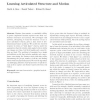Free Online Productivity Tools
i2Speak
i2Symbol
i2OCR
iTex2Img
iWeb2Print
iWeb2Shot
i2Type
iPdf2Split
iPdf2Merge
i2Bopomofo
i2Arabic
i2Style
i2Image
i2PDF
iLatex2Rtf
Sci2ools
IJCV
2010
2010
Learning Articulated Structure and Motion
Humans demonstrate a remarkable ability to parse complicated motion sequences into their constituent structures and motions. We investigate this problem, attempting to learn the structure of one or more articulated objects, given a time series of twodimensional feature positions. We model the observed sequence in terms of “stick figure” objects, under the assumption that the relative joint angles between sticks can change over time, but their lengths and connectivities are fixed. The problem is formulated as a single probabilistic model that includes multiple sub-components: associating the features with particular sticks, determining the proper number of sticks, and finding which sticks are physically joined. We test the algorithm on challenging datasets of 2D projections of optical human motion capture and feature trajectories from real videos. Keywords structure from motion · graphical models · non-rigid motion
| Added | 27 Jan 2011 |
| Updated | 27 Jan 2011 |
| Type | Journal |
| Year | 2010 |
| Where | IJCV |
| Authors | David A. Ross, Daniel Tarlow, Richard S. Zemel |
Comments (0)

